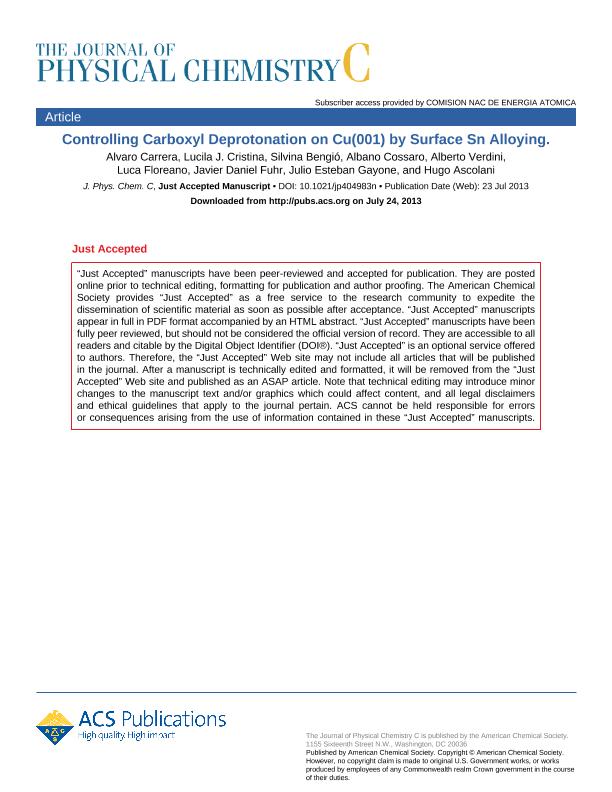Mostrar el registro sencillo del ítem
dc.contributor.author
Carrera, Alvaro Daniel

dc.contributor.author
Cristina, Lucila Josefina

dc.contributor.author
Bengió, Silvina

dc.contributor.author
Cossaro, A.
dc.contributor.author
Verdini, A.
dc.contributor.author
Floreano, L.
dc.contributor.author
Fuhr, Javier Daniel

dc.contributor.author
Gayone, Julio Esteban

dc.contributor.author
Ascolani, Hugo del Lujan

dc.date.available
2017-01-13T19:13:28Z
dc.date.issued
2013-08
dc.identifier.citation
Carrera, Alvaro Daniel; Cristina, Lucila Josefina; Bengió, Silvina; Cossaro, A. ; Verdini, A. ; et al.; Controlling Carboxyl Deprotonation on Cu(001) by Surface Sn Alloying; American Chemical Society; Journal Of Physical Chemistry C; 117; 8-2013; 1-1
dc.identifier.issn
1932-7447
dc.identifier.uri
http://hdl.handle.net/11336/11328
dc.description.abstract
We find that for adsorbed terephthalic acid (TPA) molecules surface Sn alloying deactivates the Cu(001) surface by decoupling the adsorbed molecules from the substrate. This effect is investigated for the case of the 0.5 ML phase of the Sn/Cu(001) surface alloy by applying fast X-ray photoemission spectroscopy, scanning tunneling microscopy, near-edge Xray absorption fine structure spectroscopy, and density functional theory calculations. The experimental results conclusively show that the deprotonation reaction of the carboxyl groups occurring in the clean Cu(001) is fully inhibited on this Sn/Cu(001) surface alloy, which allows the molecules to form two-dimensional arrays stabilized by [OH···O] hydrogen bonds. The formed arrays exhibit a crystal structure that is practically indistinguishable from that theoretically obtained for unsupported TPA sheets, suggesting an extremely weak molecule/substrate interaction. This is supported by DFT calculations of the adsorption energy landscape of the TPA sheets formed on the Sn/Cu(001) template: the lateral variation of the adsorption energy (corrugation) is estimated to be less than 0.2 eV, with an adsorption energy per molecule in the range 1.6−1.8 eV and a contribution of each double [OH···O] bond of 1 eV. Finally, the performed thermal desorption experiments show that the TPA sheets remain stable on the surface alloy until their desorption. From these experiments, a value of 1.5 eV was determined for the desorption energy barrier, which is consistent with the important contribution of the [OH···O] bonds to the stability of the sheets as theoretically predicted. The results reported in this study suggest that a gradual activation of the interaction between the TPA molecules and the Cu(001) surface will also be obtained for decreasing Sn coverage.
dc.format
application/pdf
dc.language.iso
eng
dc.publisher
American Chemical Society

dc.rights
info:eu-repo/semantics/openAccess
dc.rights.uri
https://creativecommons.org/licenses/by-nc-sa/2.5/ar/
dc.subject
Surfaces
dc.subject
Alloys
dc.subject
Autoassemblies
dc.subject
Hydrogen Bonds
dc.subject.classification
Física de los Materiales Condensados

dc.subject.classification
Ciencias Físicas

dc.subject.classification
CIENCIAS NATURALES Y EXACTAS

dc.title
Controlling Carboxyl Deprotonation on Cu(001) by Surface Sn Alloying
dc.type
info:eu-repo/semantics/article
dc.type
info:ar-repo/semantics/artículo
dc.type
info:eu-repo/semantics/publishedVersion
dc.date.updated
2017-01-06T20:03:59Z
dc.journal.volume
117
dc.journal.pagination
1-1
dc.journal.pais
Estados Unidos

dc.journal.ciudad
Washington
dc.description.fil
Fil: Carrera, Alvaro Daniel. Consejo Nacional de Investigaciones Científicas y Técnicas; Argentina. Comisión Nacional de Energía Atómica. Gerencia del Area de Investigación y Aplicaciones No Nucleares. Gerencia de Física (Centro Atómico Bariloche); Argentina
dc.description.fil
Fil: Cristina, Lucila Josefina. Consejo Nacional de Investigaciones Científicas y Técnicas; Argentina. Comisión Nacional de Energía Atómica. Gerencia del Area de Investigación y Aplicaciones No Nucleares. Gerencia de Física (Centro Atómico Bariloche); Argentina
dc.description.fil
Fil: Bengió, Silvina. Consejo Nacional de Investigaciones Científicas y Técnicas; Argentina. Comisión Nacional de Energía Atómica. Gerencia del Area de Investigación y Aplicaciones No Nucleares. Gerencia de Física (Centro Atómico Bariloche); Argentina
dc.description.fil
Fil: Cossaro, A. . Italian National Research Council. Istituto Officina dei Materiali; Italia
dc.description.fil
Fil: Verdini, A. . Italian National Research Council. Istituto Officina dei Materiali; Italia
dc.description.fil
Fil: Floreano, L.. Italian National Research Council. Istituto Officina dei Materiali; Italia
dc.description.fil
Fil: Fuhr, Javier Daniel. Consejo Nacional de Investigaciones Científicas y Técnicas; Argentina. Comisión Nacional de Energía Atómica. Gerencia del Area de Investigación y Aplicaciones No Nucleares. Gerencia de Física (Centro Atómico Bariloche); Argentina
dc.description.fil
Fil: Gayone, Julio Esteban. Consejo Nacional de Investigaciones Científicas y Técnicas; Argentina. Comisión Nacional de Energía Atómica. Gerencia del Area de Investigación y Aplicaciones No Nucleares. Gerencia de Física (Centro Atómico Bariloche); Argentina
dc.description.fil
Fil: Ascolani, Hugo del Lujan. Consejo Nacional de Investigaciones Científicas y Técnicas; Argentina. Comisión Nacional de Energía Atómica. Gerencia del Area de Investigación y Aplicaciones No Nucleares. Gerencia de Física (Centro Atómico Bariloche); Argentina
dc.journal.title
Journal Of Physical Chemistry C

dc.relation.alternativeid
info:eu-repo/semantics/altIdentifier/url/http://pubs.acs.org/doi/abs/10.1021/jp404983n
dc.relation.alternativeid
info:eu-repo/semantics/altIdentifier/url/http://dx.doi.org/10.1021/jp404983n
Archivos asociados
